BMW iNext: The car without dashboards
Smart technology doesn't necessarily need a screen. Sometimes it needs four wheels and a steering wheel. A look inside the BMW iNext, the concept car that merges car with smart technology.
"Do you think the car is better than the moving potato from yesterday?" asks video producer Stephanie Tresch on the way to the BMW pavilion at CES 2019 in Las Vegas. She alludes to the ride in the Aurrigo PodZero, which really can't be described as relaxed.
The German car manufacturer BMW is showing some new models and the thing we're here for: The BMW iNext. The car is a car that isn't actually a car. It is a concept car. Fully functional, but still a dream of the future. The BMW iNext is intended to show what the car industry is planning and how driving is developing. BMW's idea is particularly exciting in that the manufacturer is not focussing on autonomous vehicles, but is sticking to the concept of the driver. At least in part.
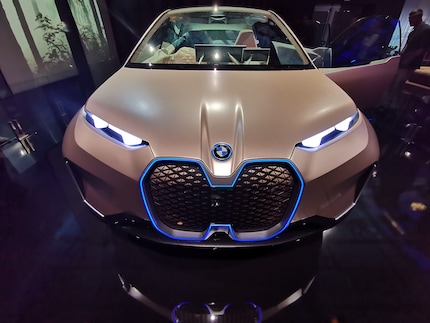
The dashboard is now just two screens
From the outside, the BMW iNext looks like a somewhat futuristic car. Finished in rose gold, the doors, bonnet and rear light up blue thanks to LED strips. Plus the car's normal lighting. We joke that the iNext wouldn't be allowed on Swiss roads as it is. We remember the days of the Hollywood film "2 Fast 2 Furious", after which all the car tuners wanted coloured underbody lighting but didn't get it.
But BMW has simply designed the car to look chic on the outside, purely aesthetically. The interior of the iNext shows what the vehicle of the future is capable of. Two screens are mounted where the dashboard is. These will display all important data for the journey and allow interaction with the fully smart vehicle and peripheral devices such as the smartphone.
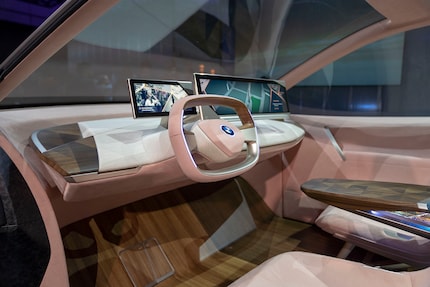
No pedals can be seen in the driver's footwell. Only when you take a second look do you see that the accelerator pedal and brake are sunk into the floor of the vehicle. This is the case with autonomous driving so that the driver has legroom and cannot interfere with the car's driving. However, when the driver takes over, the pedals are extended. As the iNext naturally shifts gears automatically, there is no longer a clutch. There is no gear stick. However, it is not entirely clear why the wooden centre console at the top lights up on the side. Many commands are to be issued via voice commands. But whether a "Hey, BMW, shift into third gear" is as quick as pushing the gear stick from the rear left to the front centre is highly doubtful.
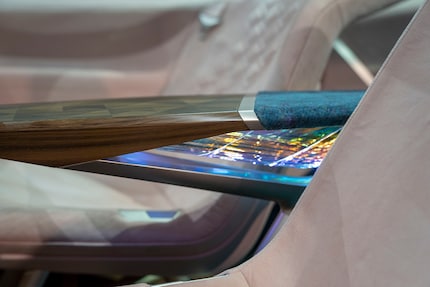
However, none of this is really that impressive. Cosmetic changes and some fancy tech. Nothing more. But that's not the end of the iNext. The futurism can be seen in the back seat.
The back seat of the 21st century
The first look at the rear seat through the doors that open backwards and not forwards - called "suicide doors" by car freaks - reveals a rather bare interior. Where are the screens? Where are the smart elements that control the climate and seat heating? And the upholstery at the back doesn't look all that comfortable either. Are you familiar with the new SBB trains that are always being criticised? The seats on the train aren't exactly soft and comfortable, but they're not really uncomfortable either. This is roughly what the rear seat of the iNext looks like. But the seats are actually a little more comfortable. Of course, they could be softer and warmer, but that's not the point of the iNext.
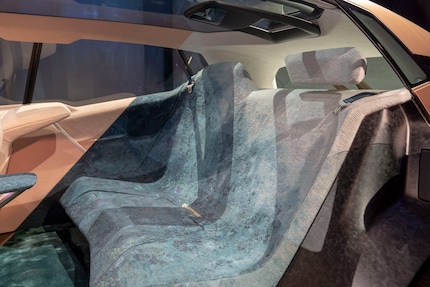
Because concept cars are one of those things. Certain elements look ready for production, others are still at the design stage and essentially a tech demo. Where the Cockpit looks finished, the rear seat probably still needs some work.
The back seat itself is a control element. If you draw a circle anywhere on the back seat with your finger, you instruct the car to turn on the music. All the gestures you know from smartphones and tablets also work on the back seat. Pinch-zoom controls the volume, swipe movements navigate back and forth between songs.
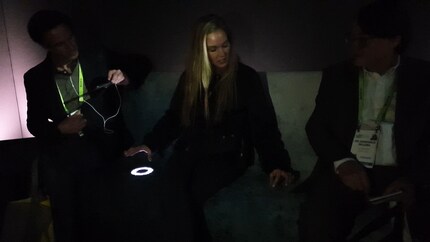
This makes buttons and controls and fittings superfluous, because the seat itself is the fitting. The advantage: the interior of the vehicle can be streamlined and passengers have more space. Above all, however, the touch-sensitive rear seat is groundbreaking. Systems are no longer connected to the car, elements become blurred and the philosophy of the Zero UI, the invisible control element, will continue to progress.
A projector is mounted above the rear seat. If you hold a smooth surface - a sheet of paper or a whiteboard - in your hands, the car projects content onto it. Screens in the front seats and the like thus become a relic from the old days.
When will the BMW iNext arrive?
The iNext is a concept, i.e. a collection of designs for future BMWs. The British car magazine Car Magazine believes it knows that the iNext will one day be launched on the market as the BMW iX7. In 2021 or so. But the magazine itself admits that this is "far from confirmed". That the iNext will not be launched on the market as seen at the CES is almost clear when you look at it. The rear-view mirrors are missing. They will be replaced by cameras, but it is difficult to imagine that the road traffic law will be adapted so quickly for a futuristic car.
It is much more likely that we will see the elements and ideas of the iNext or variants of it in future BMW models. The rear seat could suddenly be found in an M-series model, the steering wheel in the X-series. Or Car Magazine is right and the iX7 is essentially what visitors to CES will be able to see. But first impressions prove it: The iNext has massive potential, looks smart and shows the way.
You can find all articles on CES 2019 here.
Journalist. Author. Hacker. A storyteller searching for boundaries, secrets and taboos – putting the world to paper. Not because I can but because I can’t not.
From the latest iPhone to the return of 80s fashion. The editorial team will help you make sense of it all.
Show all